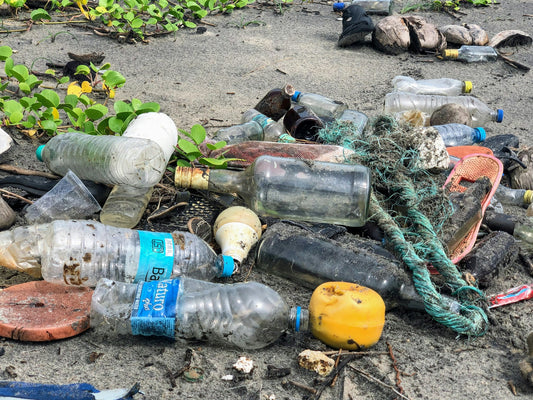Share
Keep Your Chompers Clean

Dental hygiene is an important part of maintaining good health.
Brushing alone does not remove the little food particles that find their way into your interdental spaces.
Regular flossing promotes oral health, reduces the risk for gum disease and promotes fresh breath.
There is no question that using dental floss is beneficial, but have you ever thought of the environmental impact of that seemingly harmless floss?
You may roll your eyes and think "Come on... now I'm not even allowed to use dental floss anymore", but don't worry: There are eco-friendly and healthier alternatives.
In our new series "The Dirty Truth", we explore everyday items and the role they play in the big theme of pollution.
Today: Dental Floss.
Let's dive right in and explore the ins and outs of dental floss.
Dental Floss in Numbers
It is estimated that 236 million Americans use dental floss regularly.
68% of adults use it weekly and 32% even daily.
Dental floss may not seem like a significant contributor to pollution. But if you have enough people using a small thing, it adds up.
This is similar to the famous debate about the impact of plastic straws and recent plastic straw bans in many countries.
In the case of dental floss, the amount of dental floss used every year can best be envisioned by imagining..... THE MOON.
What the fudge does the moon have to do with dental floss?
The amount of dental floss used and thrown our in America amounts to 3.2 million miles every year.
That's the equivalent of traveling to the moon and back more than six times.
Pretty significant amount, right. We think it is worth reconsidering if traditional dental floss is always the right choice.
Especially if you think about the materials that it is made of.
Dental Floss Production
Historically, dental floss was made from silk, but today, most of it is made of Petroleum-based Nylon, Polyester, or Teflon.
Plastic beads are melted and squeezed into thin strands. The strands are then stretched to make them more resistant and finally rolled onto big bobbins.
Finally, the floss is washed, waxed, flavored, and packed into small boxes you can find in the store.
As all plastic production, this process is problematic, because it involves crude oil and it is highly reource intensive.
Researchers estimate that the plastic industry is responsible for 3-5% of global carbon footprint and dental floss production is not an insignificant portion of this.
Additionally, the production of synthetic dental floss produces tiny sheds of microplastic that can easily leak into the environment, where they affect wildlife and ecosystems.
The worst candidate when it comes to environmental footprint are actually dental floss picks that come with a plastic handle.
Studies show that they have by far the worst impact in 13 of 16 measured environmental indicators, including carbon footprint.
Now that we have an idea about production, let's check out the usage of dental floss and its concerns.
Dental Floss Usage

Yes, using dental floss is encouraged by your trusted dentists.
BUT: Research suggests that synthetic dental floss can be linked to some pretty scary health risks.
These risks mainly come from the ingredients used in it.
Teflon
Many producers use Teflon to coat their floss. That's the same material that prevents your fried eggs from sticking in the pan.
Exposure to Teflon can be linked to
- Hormone imbalance
- Cancer
- Autoimmune disease
- Neurotoxicity
- Alzheimer’s disease
Nylon & Polyester
Most dental floss is made from nylon or polyester.
These materials don't break down easily, and tiny pieces can break off and end up in your body.
While nylon is likely not toxic to your body, there's uncertainty about its effects, and its production harms the environment.
If you have to choose between nylon, polyester, or Teflon floss, nylon is a the safest option, as it is used in most conventional toothbrushes.
Chemicals
Some floss brands use synthetic fragrance chemicals for flavor, often derived from petroleum.
These chemicals have been linked to serious health issues like cancer and hormonal disruptions.
Many countries have banned these chemicals, but the US allows over 3,000 "approved" fragrance chemicals without detailed disclosure.
When using flavored floss, it's especially important to check for natural flavors instead of synthetic fragrance to avoid potential health risks.
As if that weren't enough, dental floss can contain a chemical named PFAS.
PFAS is found in various consumer products and linked to liver damage, immune system harm, developmental issues, and cancer.
PFAS can persist in the body and the environment for years
Petroleum
Many dental flosses use petroleum in both the floss material and the wax coating.
Petroleum has been linked to risks such as:
- contamination with toxins
- cancer
- hormonal disruptions.
Given these health concerns, using floss with fewer chemicals is clearly a good idea.
Despite these concerns, it's still crucial to floss because not doing so can lead to oral health problems.
If you're looking for safer options, stay tuned and check out safe alternatives below that don't involve petroleum.
Dental Floss Disposal

It probably won't come as a surprise that the pollution caused by disposed of dental floss is a huge concern.
As we mentioned above, traditional dental floss is made from plastic.
This plastic is not biodegradeable and takes decades to break down on the landfill.
The thing is: not all floss makes it to the landill in the fist place.
Dental floss and other tiny plastics often get carried away during disposal, finding their way into the ocean.
Due to its tear-resistant design, the floss poses a big threat for marine life.
Similar to other plastics, dental floss can endanger marine animals, leading to suffocation or severe health problems like digestive issues.
In addition to the 3.2 million miles of dental floss that are thrown away each year, they mostly come in plastic containers.
If we assume three floss containers per year per person, that's more than 700 million dental floss containers discarded every year in the U.S. alone.
Again, those plastic containers often find their way into nature, for example as they get lost during waste transport.
After all, neither dental floss, nor the containers can be recycled due to their size.
It gets even worse if we add floss picks. The unbelievable number of 4.7 billion floss picks are thrown away every year in North America.
The weight of these floss picks would add up to more than 55 thousand adults.
As you can see, dental floss and floss picks are tiny but nasty for both nature and potentially our health.
Eco-Friendly Alternatives
Luckily there are fantastic alternatives to keep your glowing smile AND a good conscience.
Corn Fibre Floss
This natural dental floss uses the power of corn fibres and can be used just like regular dental floss.
Just rip off a small piece and glide it through your teeth.
The big difference: It does not contain plastic!

Bamboo Interdental Picks
If you're a fan of interdental sticks, there is still a great compromise.
You can still save huge amounts of plastic waste and opt for bamboo sticks.
The handle is completely made of bamboo and is fully biodegradable.and the bristles are guaranteed BPA-free.

If you're interested in an eco-friendly and natural dental routine, make sure to check out the rest of our Oral Care collection.
---
We hope you enjoyed this article. If you want to read more like this, make sure to check out our Blog and follow us on Instagram. If you are interested in our sustainable eco SWOPs, check out our Shop.








